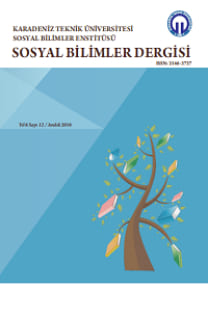OSMANLI DEVLETİ'NDE İHRACAT VE İTHALAT ARASINDAKİ UZUN DÖNEM İLİŞKİSİ: 1840-1913
Osmanlı Devleti, 1830'lu yıllarda bir dizi ticari serbestleşme hareketi gerçekleştirerek ekonomiyi dünya ekonomisine entegre etmeyi amaçlamıştır. Balta Limanı olarak bilinen ticaret antlaşması ise birçok tartışmayı da beraberinde getirmiştir. Bu antlaşma dış ticaret dengesi ve dış borç pozisyonunu olumsuz etkileyen bir gösterge olarak kabul görmesi ve içerdiği serbestleşme reformlarıyla devletin ekonomik ve politik bağımsızlığını kaybetmesine yol açtığı gerekçesiyle birçok araştırmacı tarafından tartışılmaktadır. Bu çalışmanın amacı 1840-1913 dönemi itibariyle Osmanlı Devleti'nde uygulanan makroekonomik politikaların ve serbestleşme reformlarının, kısa dönem dış ticaret açığı olgusu oluşumunda etkili olup olmadığını, ihracat ve ithalat arasındaki uzun dönem ilişkiyi Engle ve Granger (1987) ve Johansen ve Juselius (1990) eşbütünleşme testlerini kullanarak belirlemektir. İhracat ve ithalat arasında uzun dönem ilişkinin mevcut olması Osmanlı Devleti'nin dış borç pozisyonunun kötüleşmesinde Balta Limanı Antlaşması'nın etkin olmadığını göstermektedir.
THE LONG-RUN RELATIONSHIP BETWEEN EXPORTS AND IMPORTS IN THE OTTOMAN STATE: 1840-1913
In the 1830's the Ottoman government initiated a series of liberalization measures, including several trade agreements, aimed at integrating domestic economy to the world economy. The agreement known as the Treaty of Balta Liman has been subject to numerous debates. Many scholars argue that this agreement was an indication of the economic collapse in the State because of worsening the trade account and external debt position and also the liberalization reforms caused the State to loose political and economic independence and to collapse soon afterwards. The purpose of this paper is to investigate the long-run relationship between exports and imports in the Ottoman state for the period of 1840-1913 using Engle and Granger (1987) and Johansen and Juselius (1990) co-integration tests to determine whether the macroeconomic policies and liberalization reforms applied by the State were effective in making the trade deficit a short-run phenomenon. The co-integration test results indicate that there exists a stable long-run relationship between exports and imports of the Ottoman State for the period of 1840-1913. The existence of long-run relationship between exports and imports in the Ottoman State implies that the Treaty of Balta Liman is not responsible for worsening external debt position of the Ottoman State.
___
- Akaike, H. (1979). A Bayesian Extension of the Minimum AIC Procedure of Autoregressive Model Fitting, Biometrika, 66, 237-242.
- Arize, A.C. (2002). Imports and Exports in 50 Countries Tests of Co-integration and Structural Breaks, International Review of Economics and Finance, 11, 101-105.
- Babatunde, M. A. (2014). Are Exports and Imports Cointegrated? Evidence from Nigeria, Journal of International and Global Economic Studies, 7(2), 45-67.
- Bahmani-Oskooee, M. (1994). Are Imports and Exports of Australia Co-integrated, Journal of Economic Integration, 9, 525-533.
- Bahmani-Oskooee, M & Domac, I. (1995). The Long-Run Relation Between Imports and Exports in an LDC: Evidence from Turkey, Metu Studies in Development, 22, 177-189.
- Dickey, D.A. & Fuller, W.A. (1979). Distribution of the Estimators for Autoregressive Series with a Unit Root, Journal of the American Statistical Association, 74, 427-431.
- Engle, R.F. & Granger, C.W.J. (1987). Co-integration and Error Correction: Representation, Estimation and Testing, Econometrica, 55, 251-76.
- Husein, J.G. (2014). Are Exports and Imports Cointegrated? Evidence from Nine Mena Countries, Applied Econometrics and International Development, 14(1), 123-132.
- Johansen S. (1988). Statistical Analysis of Cointegrating Vector, Journal of Economic Dynamic and Control, 12, 231-254.
- Johansen, S. & Juselius, K. (1990). Maximum Likelihood Estimation and Inference on Cointegration-with Applications to the Demand for Money, Oxford Bulletin of Economics and Statistics, 52, 169-210.
- MacKinnon, J.G. (1990). Critical Values for Co-integration Tests, Economic Discussion Paper No. 90-4.
- Pamuk, S. (1995). Ottoman Foreign Trade in the 19th century, Historical statistics series, State Institute of Statistics of Ankara, Turkey, 1, 61-77.
- Rahman, M. Z. (2011). Existence of Exports-Imports Co-integration: A Study on Indonesia and Malaysia, International Business Research, 4(3).
- Sims, C.A. (1980). Macroeconomics and Reality, Econometrica, 48, 1-49.
- ISSN: 2146-3727
- Yayın Aralığı: Yılda 2 Sayı
- Başlangıç: 2011
- Yayıncı: Karadeniz Teknik Üniversitesi Sosyal Bilimler Enstitüsü
Sayıdaki Diğer Makaleler
OSMANLI DEVLETİ'NDE İHRACAT VE İTHALAT ARASINDAKİ UZUN DÖNEM İLİŞKİSİ: 1840-1913
Nebiye YAMAK, Rahmi YAMAK, Sinem KOÇAK
ALAIN TOURAINE'İN DEMOKRASİ DÜŞÜNCESİ ÜZERİNE BİR DEĞERLENDİRME
TRABZON'DA ENGELLİ KADIN PROFİLİ
Nezahat ALTUNTAŞ, Gülmelek DOĞANAY
TÜRKİYE'DE GELİR DAĞILIMININ SOSYO EKONOMİK PROFİLİ
TÜRKİYE'DEKİ MUHASEBE ANLAYIŞININ GELİŞİM SÜRECİ VE MEVCUT DURUMUN İNCELENMESİ
TÜRKİYE'DE ENFLASYON HEDEFLEMESİNİN MAKROEKONOMİK PERFORMANS ÜZERİNDEKİ ETKİLERİ
